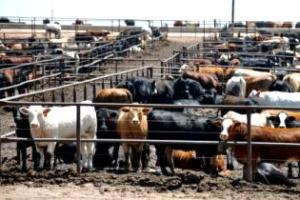CAFO Manure Management Problems
Animal manure production is an unavoidable by-product of CAFOs. In the quest for large-scale food production, there is also large-scale animal manure production. The millions of tons of manure produced annually from CAFOs have to go somewhere. Current approaches to on-farm manure storage and disposal typically involve either:
• direct application to agricultural fields for crop fertilization,
• temporary storage in earthen pits, or
• some form of manure decomposition in water (i.e., lagoons) or on land (i.e., composting) to facilitate the ease of handling and long-distance distribution
Livestock operators and farmers are limited to these options because of the magnitude of manure produced and the need for rapid disposal. The never-ending need for human food has created an  ever-growing need for efficient food production. As CAFOs have improved their production technologies, however, animal waste management needs have also increased proportionately. Unfortunately, the current approaches are completely overwhelmed by the sheer volume of manure produced every day. This has created serious environmental problems and unsustainable farm-economic inefficiencies, including the following:
ever-growing need for efficient food production. As CAFOs have improved their production technologies, however, animal waste management needs have also increased proportionately. Unfortunately, the current approaches are completely overwhelmed by the sheer volume of manure produced every day. This has created serious environmental problems and unsustainable farm-economic inefficiencies, including the following:
• The noxious odors emanating from manured agricultural fields and storage lagoons are primarily from volatilized ammonia-nitrogen (NH3-N). This ammonia is also a serious respiratory health hazard for both animals and CAFO operators. Only about 10% of the feed nitrogen remains incorporated in the animals, while the remaining 90% is excreted.
• The wind transport of volatilized ammonia can negatively impact areas miles away. For example, the Colorado Department of Public Health and Environment has recently determined that 92% of total Colorado’s ammonia emissions comes from livestock and agricultural fields. The transport and deposition of this ammonia is primarily responsible for the increasing eutrophication of the otherwise pristine mountain lakes in Rocky Mountain National Park.
• Direct application to agricultural fields is wasteful because often more than half of the ammonia-N from fresh manure has already volatilized into the atmosphere (as NH3), or has been oxidized (via bacterially-mediated nitrification) to nitrate (NO3-), and so has left the agricultural field as groundwater and surface runoff drainage. These nitrogen-rich water losses from the farm are responsible for causing eutrophication in ponds, lakes and reservoirs nationwide, as well as creating the “dead zone” in the Gulf of Mexico.
• Direct application to agricultural fields is inefficient, because the disproportionate nitrogen losses from the manure creates an imbalance in the nitrogen:phosphorus (N:P) application ratio in the manure. This creates a relative excess of phosphorus in the manure, which can also be lost from the agricultural field as runoff. The fraction of N and P in fresh manure that actually makes it into agricultural crops is small.
Not only are there legal compliance issues in addition to environmental consequences, the farmer has lost a valuable and expensive on-farm resource (nitrogen in feeds) to the atmosphere and downstream waters. As the food demand increases worldwide, so will concentrated manure production and the associated negative environmental and economic consequences.
Recent environmental legislation at both the state and the federal levels reflects the serious nature of the environmental issues involved with manure management at CAFOs. The fact that many CAFOs may not be able to survive economically under these new regulations demonstrates the lack of sustainability of our current manure management practices. The Minnesota Environmental Quality Board (1999) expressed the issue well in their comprehensive review of livestock manure management when they stated:
management at CAFOs. The fact that many CAFOs may not be able to survive economically under these new regulations demonstrates the lack of sustainability of our current manure management practices. The Minnesota Environmental Quality Board (1999) expressed the issue well in their comprehensive review of livestock manure management when they stated:
“The challenges of specialization and scale in livestock production become a constraint when individual livestock farms are unable to economically utilize the nutrients in their manure. However, the same challenges can be transformed into opportunities. Concentrated sources of manure tend to generate environmental, social, or political problems, which often help clarify for producers the need to create and market manure products for off-farm uses.”(page J-73).
As the section on Zeolites for Agricultural Crops describes, the addition of natural zeolites to animal bedding (see Zeolites for Animal Bedding) and manure storage facilities provide the means for:
• Capturing ammonia from manures for reuse on farm in order to minimize ammonia losses from farm to atmosphere, and minimize nitrate (NO3-) losses from farm to waterways.
• Making large-scale manure production a profitable commodity by retaining ammonia nitrogen, which balances the N:P ratio for efficient field applications.
• Preventing unwanted negative health, environmental, legal, and economic consequences associated with excessive ammonia production and current manure management.
In other words, the challenges outlined by the Minnesota Environmental Quality Board can be met with the inclusion of natural zeolites for CAFO manure management.
